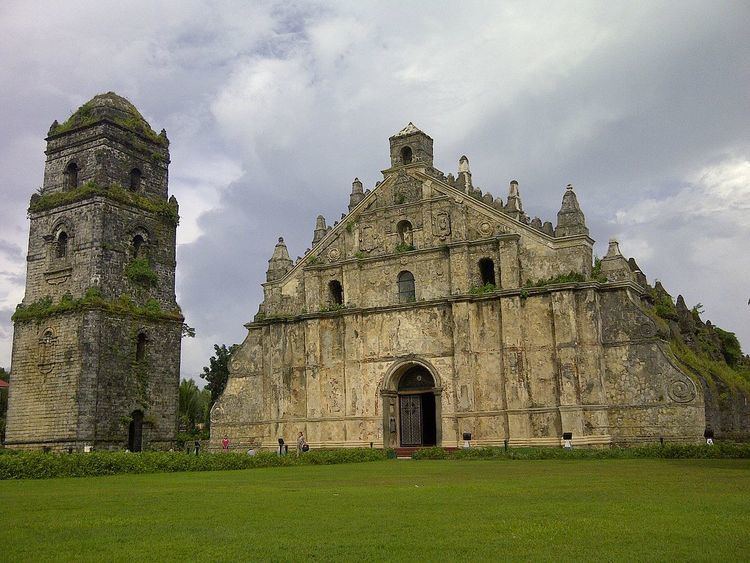Denomination Roman Catholic Length 110 m | Founded 1686 Width 40 m Completed 1710 | |
 | ||
Founder(s) Padre Antonio Estavillo Similar Malacañang of the North, Cape Bojeador Lighthouse, Baroque Churches of the Phil, Kapurpurawan Rock Formation, Calle Crisologo | ||
St augustine church paoay church of ilocos norte
The Saint Augustine Church (Spanish: Iglesia de San Agustín de Paoay), commonly known as the Paoay Church, is the Roman Catholic church of the municipality of Paoay, Ilocos Norte in the Philippines. Completed in 1710, the church is famous for its distinct architecture highlighted by the enormous buttresses on the sides and back of the building. It is declared as a National Cultural Treasure by the Philippine government in 1973 and a UNESCO World Heritage Site under the collective group of Baroque Churches of the Philippines in 1993.
Contents
- St augustine church paoay church of ilocos norte
- Paoay church
- History
- Architecture
- Buttresses
- Walls
- Facade
- Bell Tower
- Restorations
- Declarations
- References
Paoay church
History
The town of Paoay was originally called "Bombay" as the earliest inhabitants believed to have come from India. The earliest historical record of the area dates back to 1593, becoming an Augustinian independent parish in 1686. Building of the present church was started in 1894 by Augustinian friar Father Antonio Estavillo, completed in 1710 and rededicated in 1896. Some portions of the church was damaged in the 1865 and 1885 earthquake but was later restored under the initiative of former First Lady Imelda Marcos.
Architecture
Paoay church is the Philippines' primary example of a Spanish colonial earthquake baroque architecture dubbed by Alicia Coseteng, an interpretation of the European Baroque adapted to the seismic condition of the country through the use of enormous buttresses on the sides and back of the building. The adaptive reuse of baroque style against earthquake is developed since many destructive earthquakes destroyed earlier churches in the country. Javanese architecture reminiscent of Borobudur of Java can also be seen on the church walls and facade.
Buttresses
The most striking feature of Paoay Church is the 24 huge buttresses of about 1.67 metres (5.5 ft) thick at the sides and back of the church building. Extending from the exterior walls, it was conceived to a solution to possible destruction of the building due to earthquakes. Its stair-like buttresses (known as step buttresses) at the sides of the church is possibly for easy access of the roof.
Walls
Its walls are made of large coral stones on the lower part and bricks at the upper levels. The mortar used in the church includes sand and lime with sugarcane juice boiled with mango leaves, leather and rice straw. Its walls suggests Javanese architectural styles.
Facade
The stone facade appear as massive pediment rising from the ground and is built leaning towards the front. Square pilasters and stringed cornices divide the facade vertically and horizontally respectively. Its bottom part is plain. Gothic features are also present through the use of finials while the triangular pediment shows Chinese elements and Oriental strokes. Crenellations, niches, rosettes and the Augustinian coat of arms can also be seen. Facade is made of brick on the lower level and coral stones on the upper level.
Bell Tower
Adjacent to the facade is a three-storey coral bell tower constructed separately from the church building on the right side resembling a pagoda. It was in 1793 when the cornerstone of the bell tower was laid. It stands at some distance from the church as a protection against earthquake. It served as observational post for Filipino revolutionaries against the Spaniards in 1898 and by Filipino guerrillas against Japanese soldiers during World War II.
Restorations
Several projects for the restoration of Paoay Church is sought by government and non-government organizations due to possible question on its structural integrity. The local government of Ilocos Norte through resolution is seeking the reconstruction of the church's convent presently in ruins and retrofitting of the church.
Declarations
By virtue of Presidential Decree No. 260, Paoay Church was declared as a National Cultural Treasure by the Philippine government in 1973. The church was designated as a UNESCO World Heritage Site together with San Agustin Church in Manila; Nuestra Señora de la Asuncion Church in Santa Maria, Ilocos Sur; and Sto. Tomas de Villanueva Parish Church in Miagao, Iloilo on December 11, 1993.
